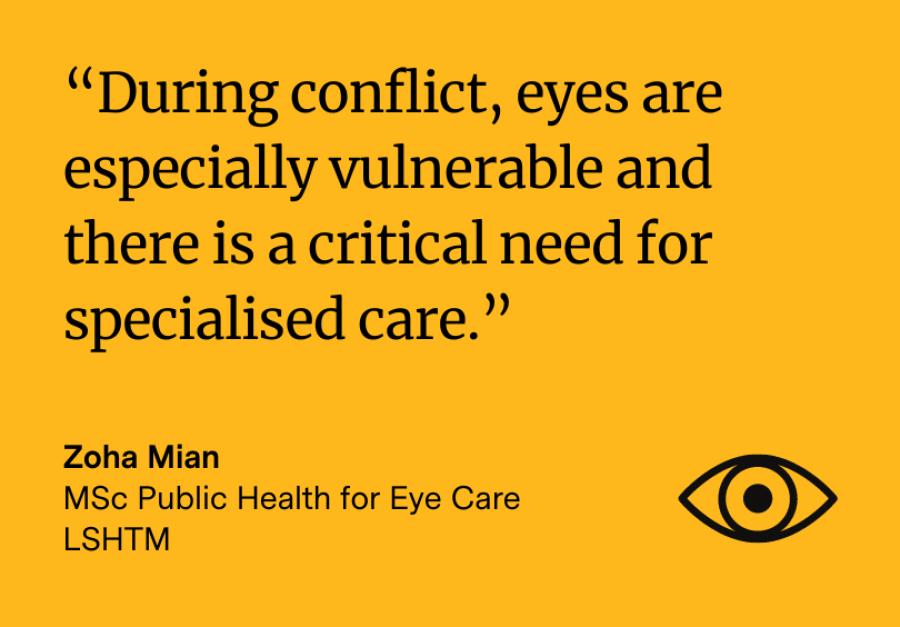
In conflict settings, eye injuries may be caused by explosives that detonate on the ground close to people or from flying debris caused by bombs. Chemical weapons, such as chlorine and mustard gas, also cause severe eye damage. Even outside of active conflict settings, remnants of war, such as landmines, continue to cause blindness. The United Nations Mine Action Service estimates there are more than 110 unexploded landmines worldwide.
Case studies: eye injuries in Afghanistan, Ukraine, and Syria
Conflicts and their aftermath highlight the ongoing impact of war on eye health and the need for adequate medical support. A 1997 study in Northern Afghanistan, a country devastated by decades of war, revealed a high incidence of eye injuries caused by explosives. Young men aged 11 to 30 were most affected, with poor recovery due to lack of transportation from rural areas to medical centres, decreased eye care services, and deteriorating health conditions.
A more recent study indicated similar patterns of eye injury in Ukraine since the Russian invasion in 2022. In the first seven months of 2023, there were over 19,000 new diagnoses of vision impairment, nearly matching the total for all of 2022. Similarly, the civil war in Syria has seen increased eye injuries, particularly among those under 18, highlighting the impact conflict has on children.
A lack of specialised care
Due to a decline in functional hospitals and a displacement of healthcare workers in conflict zones, specialised care is lacking to address eye injuries. Displaced Syrians in neighbouring countries face limited service access due to funding shortages. In 2016, the UN received only half the necessary funding for healthcare services in this region. According to Eyad Fadloun, head of medical programmes at the Union of Relief and Development Associations in Lebanon, refugees often face long wait times and high costs for eye care, such as cataract surgery, which can cost $200-700.
The cost of vision loss
Loss of vision in conflict zones significantly worsens poverty by severely restricting access to education and employment opportunities. This impact is both economic and social, as individuals affected by loss of vision face more barriers to accessing the workforce, social isolation, and lower quality of life. Conversely, access to treatments such as cataract surgery can dramatically improve outcomes, enhancing individual livelihoods and broader societal prosperity. The contrast underscores the profound importance of addressing visual impairments within conflict zones and beyond to foster wellbeing and economic growth.
Several NGOs address this issue. Orbis International operates a flying eye hospital to train women from conflict zones in eye care. Overall, the organisation has trained 18,000 eye care professionals in over 197 regions and established 416 eye health facilities. St. John Eye Hospital has been continuously functioning from its flagship hospital in Jerusalem since 1882. It has recently started to treat eye injuries in the occupied West Bank and Gaza and uses mobile clinics for those unable to travel. The UN Development Programme has also recognised the need for attention to eye injury and is piloting a visual impairment rehabilitation programme in Ukraine.
Advocating for comprehensive eye care in conflict zones
More research is needed to fully understand conflict-induced blindness and the allocation of funding for eye care in conflict zones. As current and future public health leaders, it is our responsibility to advocate for better-funded healthcare services to ensure comprehensive access to eye care, rehabilitation, and preventative measures against blindness. The long-term health impacts of conflict, including visual impairments, must not be overlooked as we strive for peace and recovery in affected regions. By increasing funding for specialised eye care, and equipping healthcare staff with the necessary supplies, we can reduce the incidence of visual impairment. This effort not only alleviates individual injury, but also fosters resilient communities. It is imperative that we prioritize eye health in our public health agendas to ensure a brighter, more inclusive future for all.
Zoha Mian, MSc Public Health for Eye Care and HHCC Student Liaison
If you enjoyed this article and would like to build a career in global health, we offer a range of MSc programmes covering health and data, infectious and tropical diseases, population health, and public health and policy.
Available on campus or online, including flexible study that works around your work and home life, be part of a global community at the UK's no.1 public health university.
